Pruning grapes in the fall: tips for beginner growers, schemes by year
Pruning grapes is quite difficult for novice winegrowers, but this is a mandatory technique, without which it is impossible to ensure an annual high yield of good quality. In order to properly prune grapes, you need to know all the subtleties and rules for the formation of fruit links of the bush, as well as the optimal timing and methods of pruning. In each case, the cutter decides which shoots are best left and which ones to remove without regret. That is why, without knowledge of the structure of the grape bush, pruning schemes for young and adult bushes, their garters to the supports, it is impossible to successfully carry out the formation of the most productive grape culture in these climatic conditions.
Next, you will learn about when and how to properly prune grapes in the fall.
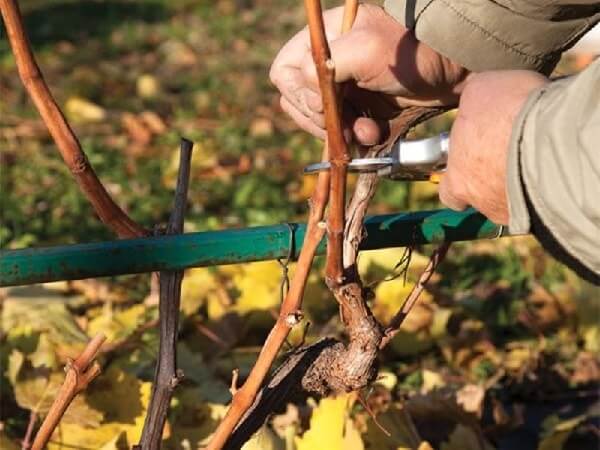
Content
Why prune grapes in the fall
As a rule, it is believed that pruning of grapes is primarily aimed at increasing the fruiting of a plant (more precisely, regulating it), that is, at the volume of the harvest, but with its help other equally important goals are achieved:
- fruit links are formed (what it is, read further);
- the influence of the polarity of the vine decreases (what it is and how it affects the vines, read below);
- the size of the bushes is reduced so that it is convenient to cover them for the winter;
- ripening of grapes accelerates;
- the size of bunches and berries increases;
- the taste of the berries themselves improves (more sugar and pulp accumulate in them);
- the care of fruit-bearing bushes and harvesting are noticeably easier.
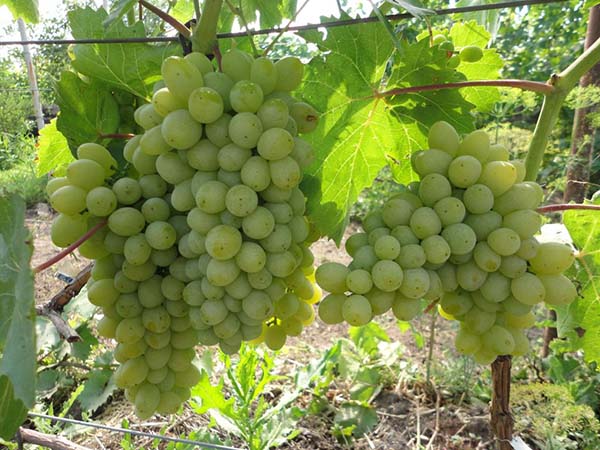
Advice! Pruning grapes must be done annually, otherwise you simply will not be able to get stable yields.
When to prune grapes in the fall
To understand when and how to prune a grape plant in the fall, you need to know the differences between spring and fall pruning, as well as take into account the most suitable natural conditions.
How autumn pruning differs from spring pruning
Pruning of grapes can be carried out both in autumn (after leaf fall) and in spring (before bud break). Butshelter uncut bush for the winter practically impossible (try to bend and place long, many-meter shoots on the ground), therefore, as a rule, pruning is carried out in the fall.
Accordingly, it turns out that in the spring cut off exactlynon-covering varieties grapes.
However! It is believed that an uncut bush tolerates winter better, because after pruning, the winter hardiness of the plant decreases.
In general, some growers prefer autumn pruning to spring, as the bushes suffer greatly in spring and cry (juice begins to flow from their wounds). Although it is not excluded cases when you cut the bushes in the fall, and took his wounds in the spring and cried. However, in any case, you cannot help. Everything will gradually drag on by itself.
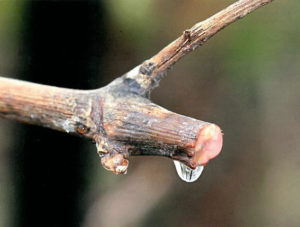
When to prune in the fall: optimal timing
Prune grapes in the fall only after natural leaf fall. If this is done prematurely, then the bush will receive less nutrients from the leaves. However, if the time has come, and the leaves are still hanging, then you need to make an artificial leaf fall, in other words, tear off the leaves with your hands or cut off with pruning shears.
When is it better to do it, in what time frame?
It is advisable to start cutting the grapes only after the first frost. Just at this time, intensive maturation of the vine occurs, and the leaves begin to turn yellow (yellowing of the leaves is a signal that they have transferred all the nutrients to the plant). And now, when the soil begins to freeze, the time has come.
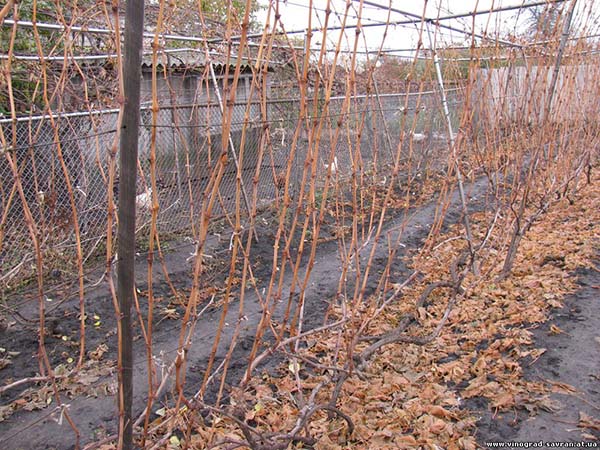
The timing of pruning grapes directly depends on the climatic characteristics of your growing area and current weather conditions. Thus, the approximate timing of autumn pruning of grapes in the middle lane (Moscow region) is the second half of October-early November.
Attention! If you do not wait for the recommended length of time, then young shoots may not have time to ripen. And if you postpone it at a later time, then frost will adversely affect the shoots - they will become too brittle.
What to do before and after pruning grapes
After you carry out the autumn pruning of the grapes before shelter, first you will need carry out treatment against diseases and pests.
In addition to these manipulations, the composition autumn activities for the care of grapes and its preparation for winter also includes:
- watering;
- top dressing;
- harvesting cuttings (during pruning);
Important! About, as properly cut grapes in the fall and store the cuttings until spring rooting, read in this article.
- bending the vine to the ground (after pruning).
- direct shelter for the winter.
How to properly prune grapes in the fall: knowledge base and pruning methods
So that even beginners can understand the system of correct pruning of grapes in the autumn period, let us dwell on the basic terminology, on the diagram of the structure of the grape bush, the principles of fruiting, as well as methods of pruning.
The structure of the vine and the necessary terminology
Before you start pruning, it is worth getting to know the structure of the grape bush. Understanding the structure of the bush and the principles of fruiting will allow you to most correctly prune.
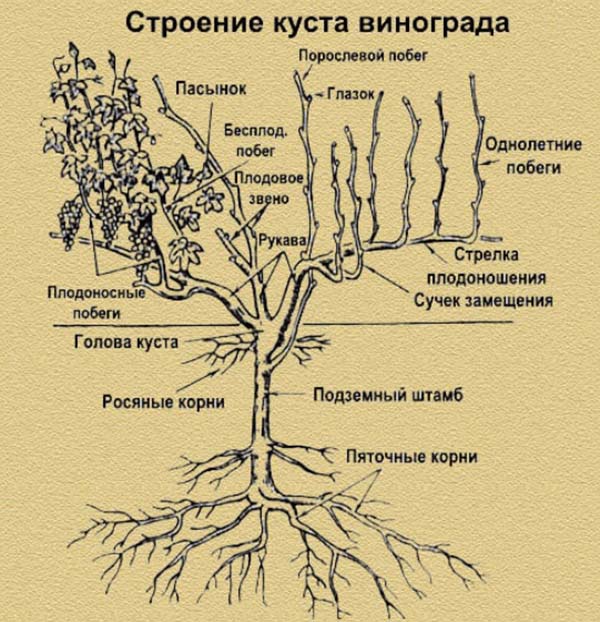
The main terms that will help you better understand the structure of the bush and, accordingly, in its pruning:
- Sleeve Is a perennial part of the grape (old wood), like the skeletal (main) branches on a tree. Each year, new fruit links are formed on the sleeves from the shoots of the last year.
- Fruit link Is a fruiting shoot (fruit arrow) and a replacement knot.
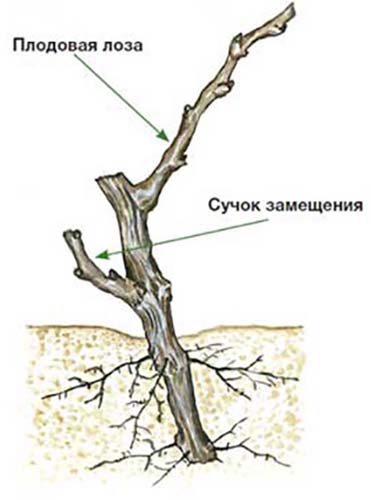
- Shoot fruiting - this is a long vine (therefore, it is more often called a fruit arrow), on which 6-10 eyes are left, of which shoots grow next year, on which the whole harvest happens.
- Replacement knot - a short vine (3 eyes), on which 3 powerful sterile shoots can grow next year, but we will not let them bear fruit (so that they grow strong), and in the fall it is among these shoots that a new fruit link will form (fruiting arrow and twig substitution).
- Peephole Is a formation that unites the kidneys and ensures their correct formation. In each such ocellus there can be several buds (one is central and several substitutes).
Comment! Very often in everyday life eyes are called wintering budsbut as you can imagine it iswrong, since there are several buds in one eye, and a young shoot can grow from each.
The principle of fruiting
The vine mainly bears fruit on young green shoots that have grown from buds on a vine last year (the fruiting arrow). Moreover, you get the main crop from the central buds, since, of course, something can grow on the replacement (lateral) or dormant buds, but much worse both in quality and quantity.
Pruning rules
Before pruning and shaping grapes, you should familiarize yourself with the basic rules and recommendations:
- You need to trim not on the ring (like fruit trees), while leaving small stump (1.5-3 cm). If you cut it shorter, then the vine in this place can dry out and die.
- Undercut fruiting vine should in internodes (that is, between the eyes), but slightly closer to the lower eye.
- If the vine not ripe, you need to trim to a ripe part (to a lignified area).
- First of all should be cut all broken off and diseased shoots (sanitary pruning), then - weak (short and thin, less than 5 mm in diameter).
- When you leave a young shoot for future fruiting, you need to delete all stepsonsso that only the vine with the eyes (buds) remains.
- Cut off all shootswhich this year there was fruiting (fruiting arrows).
- New shoots of fruiting need to leave closest to the base.
Advice! All excess young shoots are perfect for grape propagation (propagation by cuttings).
- The replacement knot is always done below the fruiting vine... If it is the other way around, then all the nutrition will go to the development of the replacement knot, since the grapes send all the juices to the distant buds.
Interesting! This is due to the fact that grapes have the property of polarity, which manifests itself in the priority development of the upper part of a bush or vine (shoots, leaves, bunches), while the lower part always lags behind in development.
Also, because of the polarity and to reduce plant damage, when removing unsuitable vine shoots, it is desirable that the wounds left are placed on only one side of the sleeve (that is, either the inside or the outside).
In general, pruning grapes is, in a sense, an effective fight against polarity, the purpose of which is to increase fruiting by minimizing its effect on the development of the bushes.
- Usually, new fruitful arrows form on replacement knots.
Advice! But if it so happened that strong shoots did not develop on the replacement knots, then the fruit link should be formed from well-developed and powerful shoots that developed on the fruiting arrow.
- The length of the shoot should correspond to the length of the trellis wire to make it comfortable tie up in spring, so there is no point in leaving too long (unless in reserve).
By the way! You can measure the optimal length simply by attaching the shoot to the trellis, in other words, by laying the shoot to the side (right or left) along the first wire. Thus, you will estimate how the grapes will be located on the trellis next year.
- Choosing one of two good shoots, you should get rid of the extreme (growing away from the trellis), which again will be inconvenient to tie in the spring.
- You should understand that during pruning, most of the growth is removed (up to 80-90%), while leaving only the required number of future fruiting vines and replacement knots.
In this way! An adult bush (3 years old and older), formed in a fan-like fashion, with 4-5 arms, should have about 30-50 eyes (depending on the variety), that is, there should be about 6-10 eyes on one vine. But in the fall, it is better to leave 2 times more (60-100 eyes), in other words, you must have a supply (spare shoots of fruiting), because during wintering, a part may freeze out or dry out.
Important! In the spring, you need to get rid of spare shoots.
Methods for pruning grapes or how many eyes to prune
It is known that each grape variety requires a kind of pruning. However, the number of eyes is also adjusted depending on the shaping method.
There are several ways to prune grapes in the fall:
- Short pruning - involves removing most of the shoots. As a result, only 2-4 eyes should remain on the fruit arrow. It is used in the cultivation of technical (wine) varieties.
- Average - each shoot after pruning contains 6-8 eyes (sometimes up to 10). It is used in the cultivation of table varieties.
- Long - more than 8-12 eyes are left on the shoot. Typical for the cultivation of table and Asian grapes.
- Mixed (according to Guyot) - this method of forming a bush involves a short and long technique. Shoots are cut for replacement (by 3 eyes), and fruit arrows are left, on which a new crop will ripen in the next season. Thus, with the help of this method, a loop is formed - the fruit vine, having fruited, is cut off, and in its place a new fruitful shoot is launched into growth, which has grown on a replacement knot.
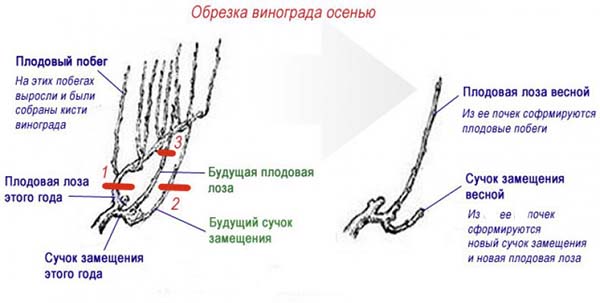
Advice! Carefully study the information about a particular variety, because the correct pruning method depends on how many and what bunches of grapes you get.
If there is no way to find out, then use either the medium pruning method, or even better - mixed (according to Guyot), which with a replacement knot.
How to form grapes: pruning schemeyoungbushes in autumn 1, 2, 3 years
Let's take a closer look at how to properly shape and prune grapes every fall for 3 years after planting.
Remember! The goal of your pruning is to have 4-5 fruit-linked sleeves by age 3.
Grape pruning 1st year
You planted grape seedling in spring, and now it's time for the first formative pruning.
Pruning grapes in the fall of the 1st year is carried out as follows: you shorten your only shoot by 3-4 eyes. If you had a seedling with two shoots, then pruning should be done symmetrically, but leaving 2-3 eyes.
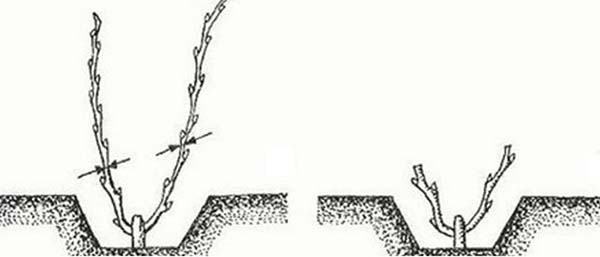
Opinion! Some particularly scrupulous growers believe that while the bushes are young, only preliminary pruning should be done in the 1st and 2nd years in the fall (that is, in the first year you need to leave 6-10 eyes), and the next year in early spring - the final one (up to 3 -4 eyes). The fact is that if you cut it too short at once, then in winter, due to its youth and insufficient frost resistance, the vine can completely freeze out.
Grape pruning 2nd year
If you did everything right last fall, then this fall you already have 4-5 powerful shoots (future sleeves). In this case, it is better to leave exactly 4 shoots, and the weakest or growing in an uncomfortable direction should be cut out.
Important! The bush should not look like a fan of 6-8 short shoots, 4-5 strong and long shoots should remain on it. Therefore, do not forget to carry out the summer minting.
Pruning grapes in the fall of the 2nd year is carried out as follows: you shorten each of the shoots by 3-4 eyes, which is necessary (if it is not clear, then see paragraph "Pruning rules") so that each shoot can be normally tied to the lower wire of the trellis, that is, be located along it and not go beyond its limits.
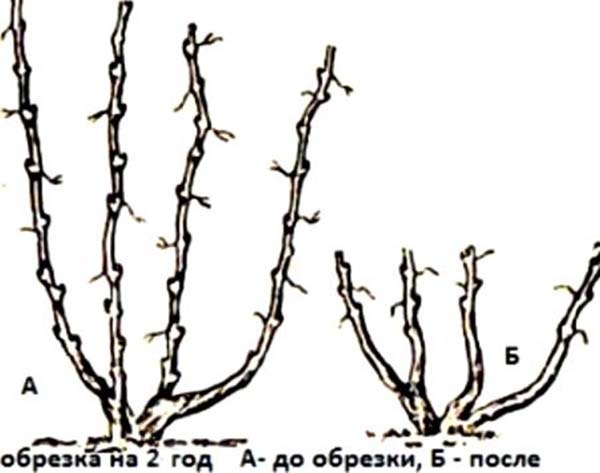
The next video shows the preliminary pruning of grapes in the second year in the fall (that is, the vine is left with a large margin, not 3-4 eyes, but 2 times more, that is, 6-8).
Advice! A stock of vines is never superfluous, because in the spring you can always complete what you started and get rid of what is not needed.
Pruning grapes of the 3rd year and beyond
In the fall of the third year, the shrub will already have 4 large boles (arms), with young branches on each of them. It is on these young vines that you will begin to harvest.
By the way! Already for 3 years you will receive a small "signal" harvest.
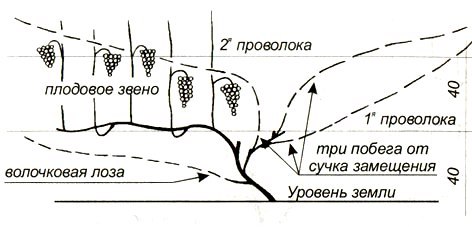
For the correct pruning of grapes in the fall of the 3rd year, the strongest shoots on each side (on each sleeve) are again selected, the weak ones are cut out and 2 strong ones are left. Of the remaining 2 powerful shoots, the lower one is shortened by 3 eyes. This will be a replacement knot. The second shoot (fruit arrow) is left with 6-10 buds.
Advice! Still, it is better to hibernate 2 strong vines (fruit arrows), and in the spring remove the one that wintered worse or is located further from the base of the bush.
Thus, in the third year, a grape bush will be fully formed, which in the future will begin to actively bear fruit.
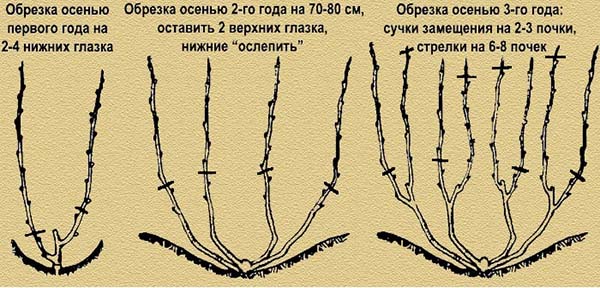
Further! In the fourth year and in all subsequent years, autumn pruning of grapes consists in removing the vine that has already fruited, and pruning the annual vine (the one that grew on the replacement heap), which will bear fruit next year (fruit arrow). The lowest vine will again be left as a replacement knot.
See the next paragraph, "Pruning a Mature Grape Bush in Autumn".
How to prune a mature grape bush in the fall
Note! Most often grapes are formed in a fan in 4-5 sleeves (multi-arm fan) on a 2-plane trellis (on 1 plane they are usually formed into 3 sleeves). It is on the example of such a bush that detailed instructions for its autumn pruning will be given below.
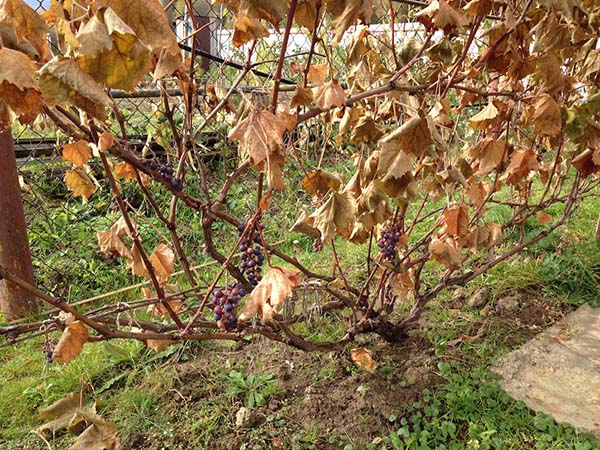
Step-by-step instructions for pruning adult (3 years and older) grapes in the fall for beginners:
Attention! Before you start pruning an adult bush according to the step-by-step guide below, carefully study all the information about the structure of the bush and the rules for pruning grapes, which are presented above in separate paragraphs.
- We start with first sleeve... Suppose that it has 4 shoots and 1 fertile one, but only 2 good and powerful shoots (vine of future fruiting) and 1 replacement twig need to be left.
- First, all the extra weak shoots are removed, as well as the already fruiting vine of the last year.
- The lower vine is then left on a replacement knot and cut into 3 buds.
- Further, on the 2 left vines of future fruiting (fruit arrows), you need to count 6-10 eyes, and cut off the rest.
Important! The eyes should be counted from the lower trellis wire, since the lowest ones are usually sterile.
- Let's go to second sleeve... Suppose that it is the most undeveloped and has only 2 young shoots on it. It turns out that the lower shoot needs to be left on the replacement knot, and the upper one will become a fruiting shoot. Naturally, the sprouted shoot should also be removed.
Important! In the fall, you need to leave exactly two shoots (each with 6-10 eyes), that is, 1 is the main one, 2 is a spare (in case of the death of the vine - damping out or freezing of the eyes). Already in the spring, if both shoots survive, the lower one will need to be cut off for a replacement knot, and the upper one should be left for fruiting.
- Third sleeve... Let's assume that there are 3 young shoots on it and 1 fertile one (of course, you need to get rid of it). However, 1 out of 3 shoots is located at the very bottom, and it is the weakest, it is this that should be made a replacement knot, and the rest 2 - with fruiting vines.
- Fourth sleeve... Another sleeve with only 2 young shoots. Again, we act as with 2 sleeves - the lower one is left on the replacement knot (but we cut it off not by 3 buds, but by 6-10), and the upper one - by the fruiting arrow. And, of course, we get rid of the fruiting shoot.
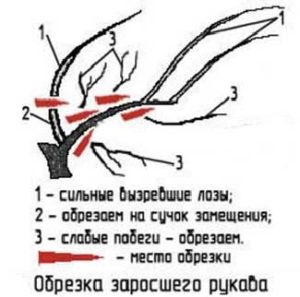
Important! In the spring you should remove all open eyes that are below the bottom wire, except those on the replacement knots. And also all spare shoots of fruiting, leaving only those that are located closer to the base of the bush.
Try it! Some grape varieties are recommended to be grown with reinforced fruit links (with more stress), as shown in the diagram below.
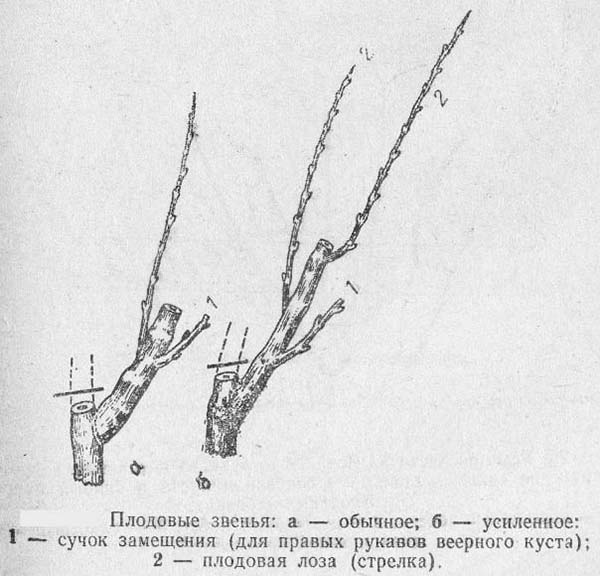
Note! After 7-8 years, excessively elongated and outdated sleeves (which are already thickening the landings) begin to be replaced with new ones. This process is called rejuvenation of the grape bush... You cut the entire sleeve on a stump, and instead of coppice shootgrowing out of the ground next to a bush (initially it is recovery bitches), or from the very bottom shoot growing on this old sleeve, called "spinning top”, You start to grow and form a new one.
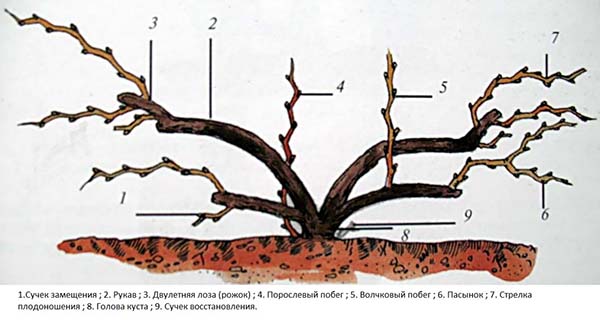
How to cause the least damage to the plant and at the same time remove unnecessary shoots correctly? To understand this issue, a novice summer resident needs to take a responsible approach to studying the entire system of pruning grape bushes: schematic pictures of the structure and pruning of young and adult grapes, as well as recommendations for the skillful formation and garter of a bush.
Video: pruning a grape bush in the fall
Interesting! Unfortunately, there is always a certain psychological barrier between knowledge and action, namely: a novice winegrower (who has read a lot of useful advice on pruning grapes in autumn) approached his overgrown bush, looks at it and does not understand where is which vine, what to cut, what leave. And that's okay. Only practice will help you in solving this problem.

